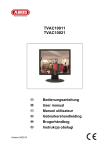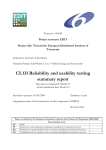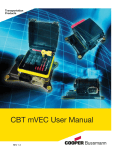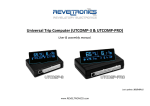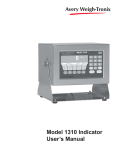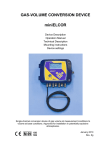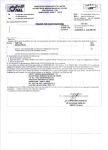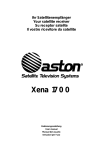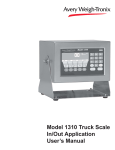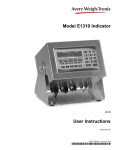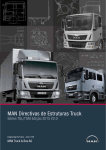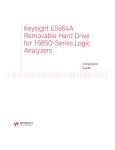Download CMVR Type Approval of Vehicles Retrofitted with Hybrid Electric
Transcript
Draft AIS-123 /F1 February 2013 FINALISED DRAFT AUTOMOTIVE INDUSTRY STANDARD CMVR Type Approval of Vehicles Retrofitted with Hybrid Electric System ARAI Date of hosting on website : 15th February 2013 Last date for comments : 15th March 2013 1/52 Draft AIS-123/F1 February 2013 CHECK LIST FOR PREPARING AUTOMOTIVE INDUSTRY STANDARD Draft AIS-123: CMVR Type Approval of Vehicles Retrofitted with Hybrid Electric System SR. NO. 1. PARTICULARS REMARKS Indicate details of the base reference standard. ( eg. ECE / EEC Directive/GTR etc.) AIS 102 (Part 1) 2. Add an explanatory note indicating differences Nil between the above standard and the draft, if any. 3. Specify details of technical specifications to be Included in the standard (Annex E submitted at the time of type approval relevant to the and Annex F) requirements of this standard covered. 4. Are the details of Worst Case Criteria covered? Not applicable. 5. Are the performance requirements covered? Yes 6. Is there a need to specify dimensional requirements? No 7. If yes, are they covered? NA 8. Is there a need to specify COP requirements? If yes, are they covered? Will be considered in future 9. Is there a need to specify type approval, and routine No test separately, as in the case of some of the Indian Standards? If yes, are they covered? NA 10. If the standard is for a part/component or sub-system; i) ii) AIS-037 or ISI marking scheme be Yes for HES kit implemented for this part? Are there any requirements to be covered for Yes this part when fitted on the vehicle? If yes, has a separate standard been prepared? 11. Present standard includes vehicle installation performance tests as well If the standard is intended for replacing or revising an NA already notified standard, are transitory provisions for re-certification of already certified parts/vehicles by comparing the previous test result, certain additional test, etc. required? If yes, are they included? 2/52 12. Draft AIS-123/F1 February 2013 Include details of any other international or foreign No international standard reference national standards which could be considered as available alternate standard. 13. Are the details of accuracy and least counts of test No equipment/meters required to be specified? If yes, have they been included? 14. What are the test equipments for establishing Regular test equipment for approval compliance? of OE hybrid electric vehicles 15. If possible, identify such facilities available in India. 16. Are there any points on which special comments No or information is to be invited from members? If yes, are they identified? 17. Does the scope of standard clearly identify vehicle Yes categories ? 18. Has the clarity of definitions been examined? 3/52 ARAI, Pune ICAT, Manesar VRDE, Ahmednagar Yes Draft AIS-123/F1 February 2013 Introduction The Government of India felt the need for a permanent agency to expedite the publication of Standards and development of test facilities in parallel when the work of preparation of Standards is going on, as the development of improved safety critical parts can be undertaken only after the publication of the Standard and commissioning of test facilities. To this end, the Ministry of Surface Transport (MoST) has constituted a permanent Automotive Industry Standard Committee (AISC) vide order no. RT-11028/11/97-MVL dated September 15, 1997. The Standards prepared by AISC will be approved by the permanent CMVR Technical Standing Committee (CTSC) after approval, The Automotive Research Association of India, (ARAI), Pune, being the secretariat of the AIS Committee, has published this Standard. For better dissemination of this information, ARAI may publish this document on their website. This Standard prescribes the CMVR Type Approval requirements for In-use vehicles retrofitted with Hybrid Electric System. Considerable assistance has been taken from the following ECE regulations: 1. ECE R 100 : Uniform provisions concerning the approval of REESS electric vehicles with regard to specific requirements for the construction and functional safety. 2. ECE R 101 : Uniform provisions concerning the approval of passenger cars powered by an internal combustion engine only, or powered by a hybrid electric power train with regard to the measurement of the emission of carbon dioxide and fuel consumption and/or the measurement of electric energy consumption and electric range, and of categories M1 and N1 vehicles powered by an electric power train only with regard to the measurement of electric energy consumption and electric range. 4/52 Draft AIS-123/F1 February 2013 CMVR Type Approval of Vehicles Retrofitted with Hybrid Electric System 1.0 SCOPE This standard lays down the requirements specific to vehicles retrofitted with hybrid electric system (HES) of M1,M2 and N1 category of vehicles, which i) ii) iii) iv) 2.0 Comply to BS-II or subsequent emission norms, Operate on either Petrol or Diesel fuel only, Have GVW not exceeding 3500 kg, Have not been retrofitted earlier or are not operating on any other alternate fuel. REFERENCES a) AIS-038 : Electric Power Train Vehicles – Requirements for Construction and Functional Safety b) AIS-039 : Electric Power Train Vehicles – Measurement of Electrical Energy Consumption c) AIS-041 : Electric Power Train Vehicles :Measurement of Net Power and the Maximum 30 Minute Power and Speed d) AIS-049 : Electric Power Train Vehicles - CMVR Type Approval for REESS Operated Vehicles e) AIS-053 : Automotive Vehicles – Types – Terminology f) IS 2 : Rules for Rounding off Numerical Values g) IS 11852: : 2001 h) IS 11825-1986 : Vehicle Weightment. i) IS 3028-1998 : Automotive Vehicles – Noise Emitted by moving Vehicles- Method of measurement j) AIS 003-1999 : Automotive Vehicles - Starting Gradeability Method of Measurement and Requirements Automotive Vehicles - Brakes and Braking Systems k) AIS 004 (Part 1):1999 : Electromagnetic Radiation from Automotive Vehicle – Permissible Levels & Methods of Tests 5/52 Draft AIS-123/F1 February 2013 l) AIS 004 (Part 3):2009 : Automotive Vehicles –Requirements for Electromagnetic Compatibility m) AIS 008 (Rev.1) Vertical Orientation of dipped beam – Head Lamp : n) ISO 6722 - 2006 : Road vehicles – 60V and 600V single core cables – Dimensions, test method and requirements. o) JASO D 616:2011 : Automotive parts – Test method and general performance requirements for wiring harness connectors. p) ECE R101 R2 amd2 : Uniform provisions concerning the approval OF passenger cars powered by an internal combustion engine only, or powered by a hybrid electric power train with regard to the measurement of the emission of carbon dioxide and fuel consumption and/or the measurement of electric energy consumption and electric range, and of categories M1 and N1 vehicles powered by an electric power train only with regard to the measurement of electric energy consumption and electric range. : Emission testing procedures q) TAP 115/116 3.0 DEFINITION For the purpose of this draft the following definitions shall apply 3.1 Hybrid Electric System (HES): Means Aggregate of components added by manufacturer/ supplier to the base vehicle for Hybrid Electric operation without modification/change/fuel type of base vehicle power train and base vehicle configuration. 3.2 OVC range: The total distance covered during complete combined cycles run until the energy imparted by external charging of the REESS (or other electric REESS device) is depleted, as measured according to the procedure described in Appendix-2 of Annexure A. 3.3 Where necessary, the definitions given in Annexure E of AIS-049 shall apply. 4.0 VEHICLE WEIGHTMENT 4.1 Vehicle Weightment shall be done as per IS 11825-1986 with retrofitted HES. Permissible increase in vehicle unladen weight due to HES shall be as follows: Vehicle Category M1/M2? M1/M2? N1 ULW (kg) Permissible increase in ULW (%) <= 1100 21 > 1100 17 -Equal to weight of HES 6/52 Remarks --Payload shall be reduced to the extent of HES weight Draft AIS-123/F1 February 2013 5.0 COAST DOWN TEST Coast down test shall be done at the choice of HES manufacture/supplier to find out vehicle coefficient for exhaust emission test. Otherwise power table method shall be used. 6.0 VISUAL INDICATION HES manufacturer/supplier shall provide minimum following indications. - REESS SOC Motor temperature HES Fault These indications shall be as per the guidelines of AIS 071 Part 1. 7.0 GRADEABILITY TEST 7.1 Test shall be carried out as per AIS 003-1999 with increased Weight of HES as declared by HES manufacturer / HES Supplier. 8.0 MASS EMISSION TEST PROCEDURE 8.1 Emission Test procedure for vehicles retrofitted with hybrid electric system is as per annexure A. The HES retrofitted vehicle shall meet base vehicle model year exhaust emission norm. The Emission test procedure shall be as per MoRTH/CMVR/TAP-115/116 with changes as given in Annexure A. 9.0 BRAKE PERFORMANCE 9.1 Brake performance test for Vehicles retrofitted with Hybrid Electric System (HES) shall be carried out with increased Weight of HES as declared by HES manufacturer / HES Supplier. The brake performance shall be evaluated as per IS 11852-2001 (Part 3 to Part 9) and Annexure B. 10.0 MEASURMENT OF PASS BY NOISE LEVEL Test shall be carried out as per IS 3028-1998. 10.1 Test shall be conducted on vehicle retrofitted with HES in following two different modes; 1. Without powering Hybrid Electric System and result shall be recorded 2. With powering Hybrid Electric System and result shall be recorded. 7/52 Draft AIS-123/F1 February 2013 10.2 Test result verification method Values of results with powering HES shall not be more by 2 dB than the values of results without powering HES. 11.0 TRACTION MOTOR TEST Following test shall be carried out on traction motor. 11.1 Motor Power Test: Test shall be carried out as per AIS 041. 11.2 Environmental validation tests for Traction Motor: Manufacturer/supplier of Hybrid Electric System should provide the test reports of the following tests Conducted on Traction Motor. a. Thermal Shock test : Test shall be carried out as per IS:3141:2007 b. Media resistance test : Test shall be carried out as per IS:3141:2007 c. Impact test : Test shall be carried out as per IS 9000 Part 7/Sec1: 2006 d. Dust Test : Test shall be carried out as per IS: 3141:2007 e. Water immerse test : Test shall be carried out as per IS: 8925:1978. 12.0 EMI TEST 12.1 Test shall be carried out on component level as per AIS 004 (Part1):1999. REESS charger shall be excluded from the test as it utilized when vehicle is in off condition. 13.0 EMC TEST 11.1 Test shall be carried out on component level as per AIS 004 (Part3):2009 as and when it becomes applicable. 14.0 VERTICAL ORIENTATION OF DIPPED BEAM – HEAD LAMP 12.1 HES Manufacturer / HES Supplier shall carry out Head Lamp Leveling adjustment on retrofitted vehicle at the time of submition of the vehicle for type approval. For such adjustment, refer procedure given in AIS-008. Declaration to this effect shall be provided by HES Manufacturer / HES Supplier to the Type Approval test agency. 15.0 REQUIREMENTS FOR CONSTRUCTIONAL & FUNCTIONAL SAFETY 15.1 Requirements for Constructional & Functional safety shall be as per requirements laid down in Clause no 11.0 of AIS 102 (Part 1):2009. 8/52 Draft AIS-123/F1 February 2013 16.0 REQUIREMENTS FOR RECHARGEABLE ENERGY STORAGE SYSTEM (REESS) 16.1 Requirements for REESS shall be applicable as per AIS048. For HES component level testing will be done. The test reports provided by HES manufacturer / HES Supplier shall also be considered as compliance to this requirement. 17. 0 WIRING HARNESS / CABLES / CONNECTORS 17.1 Manufacturer/supplier of Hybrid Electric System should comply with the following standards and Guidelines for Control, Power harness and all connectors used in harness. OR Manufacturer/supplier of Hybrid Electric System should provide the test reports of the following tests Conducted on Control, Power harness and all connectors used in harness as given in 17.2 and 17.3 17.2 The cables used in the harness shall comply with following tests as mentioned in ISO6722_2006. a. Electrical characteristicsWithstand Voltage : 17.3 Test shall be carried out as per clause 6.2 Of ISO 6722-2006. b. Low temperature Characteristics : Test shall be carried out as per clause 8 of ISO 6722-2006. c. Heat ageing – Thermal Overload : Test shall be carried out as per clause 10.3 Of ISO 6722-2006. d. Resistance to chemicals Fluid compatibility : Test shall be carried out as per clause 11.2.2 & 11.2.3 of ISO 6722-2006. e. Resistance to flame propagation : Test shall be carried out as per clause of ISO 67222006. General guidelines for performance and reliability of single pole and multi pole connectors for wiring harness. Counter mating connector shall be used to pig tail any existing connector. The mating connector shall meet the following requirements. JASO D 616:2011 Standard can be referred. 9/52 Draft AIS-123/F1 February 2013 a. Water ingress protection when water is splashed during driving or the vehicle is washed b. Sufficient tensile strength of crimped connections. c. Connector housing lock strength and terminal retention d. Connection resistance shall be < 10 mOhms e. Leakage current shall not exceed 1 mA for non-water proof connector and 50uA for water proof connector. f. Insulation resistance shall be > 100MOhms. 18 TECHNICAL SPECIFICATION 18.1 Technical Specification for Hybrid Electric System and vehicles retrofitted with Hybrid Electric System shall be as per Annexure E & F resp. 19 CODE OF PRACTICE: 19.1 HES manufacture/supplier/Authorized retrofitter shall comply code of practice as per Annexure G. Documentary evidence shall be provided at the time of Type Approval along with technical specification. Annual check-up of Type Approved vehicle shall be verified as per CODE OF PRACTICE ANNEXURE G 20.0 CHANGE IN THE TECHNICAL SPEDIFICATIONS ALREADY TYPE APPROVED 20.1 Every modification pertaining to the information declared in accordance with paragraph 15 shall be intimated by the HES manufacturer/supplier to the testing agency. 20.2 If the changes are in parameters not related to the provisions of this standard, no further action need be taken. If the changes are in parameters related to the provisions of this standard, the testing agency shall then consider, whether, a) the model with the changed specifications still complies with provisions of this standard; or, b) any further verification / testing is required to establish compliance. For considering whether any further verification / testing is required or not, guidelines given in Annexure H shall be used for the electrical requirements. For other cases, the guide lines given in the individual standard shall be applicable. 20.3 In case of 20.2 b), verification for only those parameters which are affected by the modifications needs to be carried out. 10/52 20.4 Draft AIS-123/F1 February 2013 In case of fulfillment of criterion of para 20.2 a) or after results of further verification as per para of 20.2 b) are successful, the approval of compliance shall be extended for the changes carried out. 20.5 Tests such as Evaporative emission, crankcase emission, idling emission, full load smoke (for diesel engine vehicles) etc. need not be carried out, if the related technical specification is same as those of a model already type approved. 21 VALIDITY OF ANNEXURES It is expected that in due course of time the details given in Annexures A & C would be incorporated in CMVR AIS 102 (Part1) and other related documents referred in this draft. Once, such an incorporation takes place, the details given in these annexures would be automatically defunct. 22 TRANSITORY PROVISIONS 22.1 Testing agency may issue a provisional certificate of compliance to CMVR for vehicles retrofitted with HES, based on compliance to this standard, before this standard is adopted by CMVR TSC and/or notified in CMVR. Such provisional certificates shall indicate the following: “This certificate is issued based on compliance to draft notification, which is not yet notified in CMVR. This certificate is valid for a period of 6 months from date of notification of this standard and needs to be revalidated thereafter.” 23 VALIDITY OF TYPE APPROVAL CERTIFICATE 23.1 Testing agency shall issue Type Approval certificate only by model basis. 23.2 Validity of such TA certificate shall be 3 years and needs to be revalidated thereafter. During revalidation HES installed vehicle will be subjected to only mass emission test and physical verification of the vehicle as per the Layout submitted by HES manufacturer / HES supplier during initial type approval. 11/52 Draft AIS-123/F1 February 2013 ANNEXURE A (See 6.1) Test Procedure for Measurement of Mass Emissions, Fuel Consumption and Hybrid Range of Vehicles Retrofitted with Hybrid Electric System. A-1.0 Categories of vehicles retrofitted with HES are mentioned below. Vehicle charging Operating mode switch Off Vehicle Charging (OVC) 1/ without with 1/ 2/ A-2.0 Not Off Vehicle Charging (NOVC) 2/ without with also known as “externally chargeable” also known as “not externally chargeable” Vehicles Retrofitted with Hybrid Electric System (Externally chargeable) without an operating mode switch. Two tests shall be performed under the following conditions (a) Condition A: test shall be carried out with a fully charged electrical energy / power storage device. (b) Condition B: test shall be carried out with an electrical energy/power storage device in minimum state of charge (maximum discharge of capacity). (c) The profile of the state of charge (SOC) of the electrical energy/power storage device during different stages of the Type I test is given in Appendix 1 of this Annexure. A-2.1. Condition A A-2.1.1. Discharge of REESS The procedure shall start with the discharge of the electrical energy/power storage device as described in paragraph 2.1.1.1 below: 2.1.1.1 Discharge of the electrical energy/power storage device The electrical energy/power storage device of the vehicle is discharged while driving (on the test track, on a chassis dynamometer, etc.): a) At a steady speed of 50 km/h until the fuel consuming engine starts up b) Or, if a vehicle cannot reach a steady speed of 50 km/h without starting up the fuel consuming engine or for other reasons, 12/52 Draft AIS-123/F1 February 2013 the speed shall be reduced until the vehicle can run at a lower steady speed where the fuel consuming engine just does not start up for a defined time/distance (to be specified between testing agency and HES HES manufacturer/supplier/HES supplier). c) Or with HES HES manufacturer/supplier’s/HES supplier’s recommendation. The fuel consuming engine shall be stopped within 10 seconds of it being automatically started. A-2.1.2 Conditioning of Vehicle A-2.1.2.1 Vehicle with Compression Ignition Engine For conditioning compression-ignition engined vehicles the Part Two cycle of the applicable driving cycle shall be used in combination with the applicable gear shifting prescriptions as defined in paragraph A2.1.4.2 of this annexure. Three consecutive cycles shall be driven. A-2.1.2.2 Vehicle with Positive Ignition Engine Vehicles fitted with positive-ignition engines shall be preconditioned with one Part One and two Part Two cycles of the applicable driving cycle in combination with the applicable gear shifting prescriptions as defined in paragraph A-2.1.4.2 of this annexure A-2.1.3 Soak A-2.1.3.1 After this preconditioning, and before testing, the vehicle shall be kept in a room in which the temperature remains relatively constant between 293 and 303 K (20 °C and 30 °C). This conditioning shall be carried out for at least six hours and continue until the engine oil temperature and coolant, if any, are within +/-2 K of the temperature of the room, and the electrical energy/power storage device is fully charged as a result of the charging prescribed in paragraph A-2.1.3.2 below During soak, the electrical energy/power storage device shall be charged: A-2.1.3.2 (a) with the on board charger if fitted, or (b) with an external charger recommended by the HES manufacturer/supplier, using the normal overnight charging procedure (see C-4.1.2.1) This procedure excludes all types of special charges that could be automatically or manually initiated like, for instance, the equalization charges or the servicing charges. The HES manufacturer/supplier shall declare that during the test, a special charge procedure has not occurred (c) For details of end of charge, see C-4.1.3. 13/52 Draft AIS-123/F1 February 2013 A-2.1.4 Mass Emission Test A-2.1.4.1 Mass emission test shall be carried out, as prescribed for corresponding IC engined vehicle A-2.1.4.2 However, in case of special gear shifting strategy according to the HES manufacturer/supplier’s instructions, as incorporated in the drivers’ handbook of production vehicles and indicated by a technical gear shift instrument (for drivers information) shall be followed. For these vehicles the gear shifting points prescribed in MORTH/CMVR/TAP-115/116 are not applied. Measurement of Energy A-2.1.4.4 The vehicle shall be started up by the means provided for normal use to the driver. The first cycle starts on the initiation of the vehicle start-up procedure. The test procedures defined in either paragraph A-2.1.4.4.1 or A-2.1.4.4.2 may be used. A-2.1.4.4.1 Sampling shall begin (BS) before or at the initiation of the vehicle start up procedure and end on conclusion of the final idling period in the respective driving cycle (end of sampling (ES)). A-2.1.4.4.2 Sampling shall begin (BS) before or at the initiation of the vehicle start up procedure and continue over a number of repeat test cycles. It shall end on conclusion of the final idling period in the first extra-urban (Part Two) cycle during which the REESS reached the minimum state of charge according to the criterion defined below (end of sampling (ES)). The electricity balance Q [Ah] is measured over each combined cycle, using the procedure specified in Appendix 2 to This annexure, and used to determine when the REESS minimum state of charge has been reached. The REESS minimum state of charge is considered to have been reached in combined cycle N if the electricity balance measured during combined cycle N+1 is not more than 3 per cent discharge, expressed as a percentage of the nominal capacity of the REESS (in Ah) in its maximum state of charge, as declared by the HES manufacturer/supplier. At the HES manufacturer/supplier request additional test cycles may be run and their results included in the calculations in paragraphs below, provided that the electricity balance for each additional test cycle shows less discharge of the REESS than over the previous cycle. In between each of the cycles a hot soak period of up to ten minutes is allowed. The powertrain shall be switched off during this period. 14/52 Draft AIS-123/F1 February 2013 A-2.1.4.4.3 The test results on the combined cycle (Mass emission) for Condition A shall be recorded ( m1 [gms/km]). In the case of testing according to paragraph A-2.1.4.4.1., m1 is simply the results of the single combined cycle run. In the case of testing according to paragraph A2.1.4.4.2., m1 is the sums of the results of the N combined cycles run. N m1 = ∑ m i 1 A-2.1.4.4.4 Within the 30 minutes after the conclusion of the cycle, of the electrical energy/power storage device shall be charged according to paragraph C-4.1.2 and C-4.1.3. The energy measurement equipment, placed between the mains socket and the vehicle charger, measures the charge energy e1 [Wh] delivered from the mains. The electric energy consumption for condition A is e1 [Wh]. A-2.2 Condition B A-2.2.1 Conditioning of vehicle: shall be as per paragraph A-2.1.2 A-2.2.2 Discharge of REESS shall be as per paragraph A-2.1.1 A-2.2.3 After this discharge of the REESS and before testing, the vehicle shall be soaked as per paragraph A-2.1.3 A-2.2.4 Mass emission test shall be as per A-2.1.4 A-2.2.5 Measurement of Energy A-2.2.5.1 Within the 30 minutes after the conclusion of the cycle, theelectrical energy/power storage device shall be charged according to paragraph C-4.1.2 and C-4.1.3. The energy measurement equipment, placed between the mains socket and the vehicle charger, measures the charge energy e2 [Wh] delivered from the mains. A-2.2.5.2 The electrical energy/power storage device of the vehicle shall be discharged in accordance with paragraph A-2.1.1. A-2.2.5.3 Within the 30 minutes after discharge, the electrical energy/power storage device shall be charged according to paragraph C-4.1.2 and C-4.1.3. The energy measurement equipment, placed between the mains socket and the vehicle charger, measures the charge energy e3 [Wh] delivered from the mains. A-2.2.5.4 The electric energy consumption e4 [Wh] for condition B is: e4 = e2-e3 15/52 Draft AIS-123/F1 February 2013 A-2.3.0 Final Test Results A-2.3.1 In the case of testing according to paragraph A-2.1.4.4.1. The final results of pollutants for deciding on compliance and for CO2 shall be: Mi = ( De x M1i + Dav x M2i ) / ( De + Dav ) where Mi = mass emission of the pollutant i in grams per kilometer M1i = average mass emission of the pollutant i in grams per kilometre with a fully charged electrical energy/power storage device, determined as per paragraph A-2.1.4 M2i = average mass emission of the pollutant i in grams per kilometre with an electrical energy/power storage device in minimum state of charge (maximum discharge of capacity) determined as per paragraph A-2.2.4 De = vehicle electric range, according to the procedure described in Annex D., where HES manufacturer/ supplier must provide the means for performing the measurement with the vehicle running in pure electric operating state. Dav = 25 km (average distance between two REESS recharges) A-2.3.2 In the case of testing according to paragraph A-2.1.4.4.2. The final results of pollutants for deciding on compliance and for CO2 shall be: Mi = (Dovc·M1i + Dav·M2i)/(Dovc + Dav) Where: Mi = mass emission of the pollutant i in grams per kilometer M1i = average mass emission of the pollutant i in grams per kilometre with a fully charged electrical energy/power storage device, determined as per paragraph A-2.1.4 M2i = average mass emission of the pollutant i in grams per kilometre with an electrical energy/power storage device in minimum state of charge (maximum discharge of capacity) determined as per paragraph A-2.2.4 Dovc = OVC range according to the procedure described in Annex D. Dav=25 km (average distance between two REESS recharges). 16/52 Draft AIS-123/F1 February 2013 A-2.3.3 Fuel Consumption Reported fuel consumption shall be calculated by carbon balance method, as per procedure prescribed in MORTH/CMVR/TAP-115/116, except that the values of HC, CO and CO2 for calculation of fuel consumption shall be based on figures arrived at, as per paragraph A-2.3.1. OR A-2.3.2 A-2.3.4 Electric Energy Consumption A-2.3.4.1 The values of electric energy consumption shall be E1 = e1/Dtest1 [Wh/km] for condition A, and E4 = e4/Dtest2 [Wh/km] for condition B with Dtest1 and Dtest2 are the actual driven distances in the tests performed under conditions A (A-2.1.4.) and B (A-2.2.4) respectively, and e1 and e4 determined in paragraphs A-2.1.4.4. and A-2.2.5.4 respectively. A-2.3.4.2 The weighted values of electric energy consumption shall be calculated as below: A-2.3.4.2.1 In the case of testing according to paragraph A-2.1.4.4.1.: E = (De * E1 + Dav * E4) / (De + Dav) Where: E = electric consumption Wh/km E1 = electric consumption Wh/km with a fully charged electrical energy/power storage device calculated as per A-2.3.4.1. E4 = electric consumption Wh/km with an electrical energy/power storage device in minimum state of charge (maximum discharge of capacity) A-2.3.4.1. De = vehicle electric range, according to the procedure described in Annex D., where HES manufacturer/ supplier must provide the means for performing the measurement with the vehicle running in pure electric operating state.. 17/52 Draft AIS-123/F1 February 2013 Dav = 25 km (assumed average distance between two REESS recharges) A-2.3.4.2.2 In the case of testing according to paragraph A-2.1.4.4.2.: E = (Dovc·E1 + Dav·E4) / (Dovc + Dav) Where: E = electric consumption Wh/km. E1 = electric consumption Wh/km with a fully charged electrical energy/power storage device calculated as per A-2.3.4.1. E4 = electric consumption Wh/km with an electrical energy/power storage device in minimum state of charge (maximum discharge of capacity). A-2.3.4.1 Dovc = OVC range according to the procedure described in Annex D. Dav = 25 km (assumed average distance between two REESS recharges). A-3.0 Vehicles Retrofitted with Hybrid Electric System (Externally chargeable) with operating mode switch. Two tests shall be performed under the following conditions: Condition A: Test shall be carried out with a fully charged electrical energy/power storage device. Condition B: Test shall be carried out with an electrical energy/power storage device in minimum state of charge (maximum discharge of capacity) 18/52 Draft AIS-123/F1 February 2013 The operating mode switch shall be positioned according the table below A-3.1 1/ - Pure fuel consuming - Pure electric - Hybrid mode n - Pure fuel consuming - Hybrid mode m 1/ - Hybrid - Hybrid - Hybrid Switch in position Switch in position Switch in position Switch in position Condition A Fully charged Hybrid Hybrid Hybrid Most electric 2/ hybrid mode Condition B Min. state of charge Hybrid Fuel consuming Fuel consuming Most fuel consuming mode 3/ Hybrid-modes REESS State of charge - Pure electric 1/ For instance: sport, economic, urban, extra urban position 2/ Most electric hybrid mode: The hybrid mode which can be proven to have the highest electricity consumption of all selectable hybrid modes when tested in accordance with Condition A of Annex B, to be established based on information/test reports provided by the HES manufacturer/supplier and in agreement with the testing agency. 3/ Most fuel consuming mode: The hybrid mode which can be proven to have the highest fuel consumption of all selectable hybrid modes when tested in accordance with Condition B of Annex B, to be established based on information/test reports provided by the HES manufacturer/supplier and in agreement with the testing agency. A-3.2 Two tests shall be performed one under Condition A and the other under Condition B as defined in A-2.0. The test procedures for Condition A and Condition B shall be same as those given in A-2.1 and A-2.2 respectively, except that the switching modes shall be as given in A-3.1, A-3.2.1 and A-3.3. A-3.2.1 However, if the pure electric range of the vehicle measured in accordance with Annex-D is higher than one full emission test cycle, on the request of the HES manufacturer/supplier, the Type I test for condition A may not be carried out. In such cases, the value of M1i shall be taken as zero for calculation of final results. (A-2.3.1 and A-2.3.2). In this case, vehicle preconditioning prescribed in paragraph A-2.1.2 can be omitted at the request of HES manufacturer/supplier. 19/52 Draft AIS-123/F1 February 2013 A-3.3 Discharge of REESS A-3.3.1 In the case of OVC HEV’s equipped with a pure electric mode, the procedure shall start with the discharge of the electrical energy/power storage device of the vehicle while driving with the switch in pure electric position (on the test track, on a chassis dynamometer, etc.) at a steady speed of 70 per cent ± 5 per cent of the maximum thirty minutes speed of the vehicle (determined according to clause 6.0 of AIS-041). Stopping the discharge occurs when any of the following conditions happens, earliest : when the vehicle is not able to run at 65 per cent of the maximum thirty minutes speed; or when an indication to stop the vehicle is given to the driver by the standard onboard instrumentation, or after covering the distance of 100 km. A-3.3.2 In case of HEV’s not equipped with “pure electric” mode, the discharge procedure shall be as per A-2.1.1. A-3.4 Final test results shall be obtained using procedure given in A-2.3. A-4.0 Vehicles Retrofitted with Hybrid Electric System (Not Externally chargeable) without an operating mode switch A-4.1 These vehicles shall be tested according to MORTH/CMVR/ TAP-115/116 A-4.2 In the case of M and N category vehicles, for preconditioning, at least two consecutive complete driving cycles (one Part One and one Part Two) are carried out without soak. A-4.3 The vehicle shall be driven according to driving cycles prescribed, taking into account requirements given in paragraph A-2.1.4.2 in case of special gear shifting strategy. A-4.4 Special requirements for measurement and correction of the test results for CO2 and fuel consumption are given in Annexure D. A-5.0 Vehicles Retrofitted with Hybrid Electric System (Not Externally chargeable) with an operating mode switch A-5.1 These vehicles shall be tested in Hybrid mode, according to MORTH/CMVR/TAP-115/116. If several hybrid modes are available, the test shall be carried out in the mode that is automatically set after turn on of the ignition key (normal mode). On the basis of information provided by the HES manufacturer/supplier, the testing agency will make sure that the limit values are met in all hybrid modes. 20/52 Draft AIS-123/F1 February 2013 A-5.2 Preconditioning of vehicle shall be as per A-4.2. A-5.3 The vehicle shall be driven according to driving cycles prescribed, taking into account requirements given in paragraph A-2.1.4.2 in case of special gear shifting strategy. A-5.4 Special requirements for measurement and correction of the test results for CO2 and fuel consumption are given in Annexure D. A-6.0 Type II Test Methods ( Idling Emissions) for SI Engines A-6.1 The vehicles shall be tested according to MoRTH/CMVR/TAP-115/116 with the fuel consuming engine running. A-6.2 If applicable, the HES manufacturer/supplier shall provide a “service mode”??? that makes execution of this test possible, However for HEV’s using constant speed engine for charging of batteries, above test shall be exempted. A-6.3 If necessary, the special procedure provided for in paragraph A-6.4. shall be used A-6.4 It shall be possible to inspect the vehicle for roadworthiness test in order to determine its performance in relation to the data collected in accordance with the procedure prescribed in MORTH/CMVR/ TAP-115/116. If this inspection requires a special procedure, this shall be detailed in the service manual (or equivalent media). This special procedure shall not require the use of special equipment other than that provided with the vehicle 21/52 D Draft AIS-1223/F1 February 2013 ANNE EXURE A (See A-2.0(c)) App pendix 1 ELE ECTRICAL ENERGY/POWER S STORAGE D DEVICE STAT TE OF CHA ARGE (SOC C) PROFIL LE FOR OV VC-HEV’S. Th he SOC proffiles for OVC C-HEV’s tessted under coonditions A and B are: Condition C A: (1) initial state s of charge of the eleectrical energgy/power stoorage devicee (2) discharrge accordin ng to paragraaph A-2.1.1 oor A-3.3 of A Annex-A (3) vehiclee conditionin ng according g to paragrapph A-2.1.2 oof Annex-A (4) charge during soak k according to t paragraphh A-2.1.3.2 oof Annex-A (5) test acccording to paaragraph A-2 2.1.4 of Annnex-A (6) chargin ng (A-2.1.4.4 4) Condition B: (1 1) (2 2) (3 3) (4 4) (5 5) (6 6) (7 7) (8 8) initial state s of chargee vehicle conditioning g according to o paragraph A A-2.2.1 of Annnex-A discharrge according to paragraph h A-2.2.2 of A Annex-A soak acccording to paaragraph A-2..2.3 of Annexx-A test acccording to parragraph A-2.2 2.4 of Annex--A chargin ng according to t paragraph A-2.2.5.1 A discharrging accordin ng to paragrap ph A-2.2.5.2. chargin ng according to t paragraph A-2.2.5.3. A 22/52 Draft AIS-123/F1 February 2013 ANNEXURE A APPENDIX-2 METHOD FOR MEASURING THE ELECTRICITY BALANCE OF TH REESS OF OVC AND NOVC HEVS 1. Introduction 1.1. The purpose of this appendix is to define the method and required instrumentation for measuring the electricity balance of Off Vehicle Charging Hybrid Electric Vehicles (OVC HEV) and Not Off Vehicle Charging Hybrid Electric Vehicles (NOVC HEVs). Measurement of the electricity balance is necessary (a) To determine when the minimum state of charge of the REESS has been reached during the test procedure defined in paragraphs A-2.0. and A-3.0. of Annexure A; and (b) To correct the measured fuel consumption and CO2-emissions for the change in REESS energy content occurring during the test, using the method defined in paragraphs A-5.0. and A-6.0 Of annexure A. 1.2. The method described in this annex shall be used by the HES manufacturer/supplier for the measurements that are performed to determine the correction factors K fuel and KCO2, as defined in paragraphs A-4.0, and A-5.0 of this Annexure A. The Testing Agency shall check whether these measurements have been performed in accordance with the procedure described in this annexure A and Annexure D 1.3. The method described in this annex shall be used by the Testing Agency for the measurement of the electricity balance Q, as defined in paragraphs A-2.1.4.4.2, A4.0., and A-5.0. of this Annexure A and Annexure D 2. Measurement equipment and instrumentation 2.1. During the tests as described in paragraphs A-2.0, A-3.0 , A-4.0, and A-5.0. of this annexure A, the REESS current shall be measured using a current transducer of the clamp-on type or the closed type. The current transducer (i.e. the current sensor without connecting to data acquisition equipment) shall have a minimum accuracy of 0.5 per cent of the measured value (in A) or 0.1 per cent of the maximum value of the scale. Vehicle HES manufacturer/supplier diagnostic testers are not to be used for the purpose of this test. 2.1.1. The current transducer shall be fitted on one of the wires directly connected to the REESS. In order to easily measure REESS current using external measuring equipment, vehicle HES manufacturer/suppliers should preferably integrate appropriate, safe and accessible connection points in the vehicle. If that is not 23/52 Draft AIS-123/F1 February 2013 feasible, the vehicle HES manufacturer/supplier is obliged to support the Testing Agency by providing the means to connect a current transducer to the wires connected to the REESS in the above described manner. 2.1.2. The output of the current transducer shall be sampled with a minimum sample frequency of 5 Hz. The measured current shall be integrated over time, yielding the measured value of Q, expressed in Ampere hours (Ah). 2.1.3. The temperature at the location of the sensor shall be measured and sampled with the same sample frequency as the current, so that this value can be used for possible compensation of the drift of current transducers and, if applicable, the voltage transducer used to convert the output of the current transducer. 2.2. A list of the instrumentation (HES manufacturer/supplier, model no., serial no.) used by the HES manufacturer/supplier for determining: (a) When the minimum state of charge of the REESS has been reached during the test procedure defined in paragraphs A-2.0. and A-3.0. of annexure A; and (b) The correction factors Kfuel and KCO2 (as defined in paragraphs A-4.0., and A-5.0. of annexure A and the last calibration dates of the instruments (where applicable) should be provided to the Technical Service. 3. Measurement procedure 3.1. Measurement of the REESS current shall start at the same time as the test starts and shall end immediately after the vehicle has driven the complete driving cycle. 3.2. Separate values of Q shall be logged over the Part One (urban driving) and Part Two(extra- urban driving) of the MIDC driving cycle." 24/52 Draft AIS-123/F1 February 2013 ANNEXURE B (See 9.0) ADDITIONAL REQUIREMENTS FOR REGENERATIVE BRAKING SYSTEM B-1.0 Definitions B-1.1 Electric Regenerative Braking System: A braking system, which during deceleration, provides for the conversion of vehicle kinetic energy into electrical energy. B-1.2 Electric Regenerative Brake Control: A device which modulates the action of the electric regenerative braking system B-1.3 Electric Regenerative Braking System of Category A: An electric regenerative braking system, which is not part of the service braking system. B-1.4 Electric Regenerative Braking System of Category B: An electric regenerative braking system, which is part of the service braking system. B-2.0 Vehicles fitted of Category A B-2.1 The electric regenerative braking shall be only activated by accelerator control and/or the gear neutral position. In addition, for vehicles of categories M2, the electric regenerative braking control can be a separate switch or lever. B-2.2 In the case of vehicles fitted with Category A type of regenerative barking system, any separate electric regenerative braking control which is provided, shall not be used during the Type P and Type F tests. B-3.0 Vehicles fitted of Category B B-3.1 It shall not be possible to disconnect partially or totally one part of the service braking system other than by an automatic device B-3.2 The service braking system control shall also actuate the action of the electric regenerative braking system simultaneously. B-3.3 The service braking system shall not be adversely affected by the disengagement of the motor(s) or gear ratio used, except during the short duration of operation of gear shifting. with with Electric Electric Regenerative Regenerative 25/52 Braking Braking System System Draft AIS-123/F1 February 2013 B-4.0 If so desired by the HES manufacturer/supplier the performance requirements may be verified without the use of the electric regenerative system by appropriately disconnecting the system. If, so this shall be recorded in the test report. B-5.0 General For vehicles powered completely or partially by an electric motor or motor(s), permanently connected to the wheels, all tests must be carried out with these motor(s) connected. [ 26/52 Draft AIS-123/F1 February 2013 ANNEXURE C (See A-3) METHOD OF MEASURING THE ELECTRIC RANGE OF VEHICLES POWERED BY RETROFITTED HYBRID ELECTRIC POWER TRAIN AND THE OVC RANGE OF VEHICLES POWERED BY RETROFITTED HYBRID ELECTRIC POWERTRAIN (See A-2.3.1, A-2.3.3 and A-3.2.1) C-1.0 C-2.0 The test method described hereafter permits to measure the electric range and OVC range, expressed in km, of externally chargeable retrofitted HEV’s (OVC-HEV) as defined in paragraph A-1.AParameters, Units and Accuracy of Measurements Parameters, units and accuracy of measurements shall be as given in Table C-1: Table C1 Parameters, Units and Accuracy of Measurements Parameter Unit Time s Distance m Temperature C Speed km/h Mass kg Electricity Ah balance Accuracy ± 0.1 s ± 0.1 per cent ± 1C ± 1 per cent ± 0.5 per cent +/- 0.5 per cent Resolution 0.1 s 1m 1C 0.2 km/h 1 kg 0.3 per cent C-3.0 Test Conditions C-3.1 Condition of the Vehicle C-3.1.1. The vehicle tyres shall be inflated to the pressure specified by the vehicle HES manufacturer/supplier when the tyres are at the ambient temperature. C-3.1.2. The viscosity of the oils for the mechanical moving parts shall conform to the specifications of the vehicle HES manufacturer/supplier. C-3.1.3. The lighting and light-signalling and auxiliary devices shall be off, except those required for testing and usual daytime operation of the vehicle. C-3.1.4. All REESS systems available for other than traction purposes (electric, hydraulic, pneumatic, etc.) shall be charged up to their maximum level specified by the HES manufacturer/supplier. 27/52 C-3.1.5. Draft AIS-123/F1 February 2013 If the batteries are operated above the ambient temperature, the operator shall follow the procedure recommended by the vehicle HES manufacturer/supplier in order to keep the temperature of the REESS in the normal operating range. The HES manufacturer/supplier's agent shall be in a position to attest that the thermal management system of the REESS is neither disabled nor reduced. C-3.1.6. The vehicle must have run at least 300 km during the seven days before the test with those batteries that are installed in the test vehicle. This condition can be waived on request of the vehicle HES manufacturer/supplier. C-3.2 Climatic Conditions C-3.2.1 For testing performed outdoors, the ambient temperature shall be between 5 C and 32 C. C-3.2.2 The indoors testing shall be performed at a temperature between 20 C and 30 C. C-3.2.3 The test may be carried out at temperatures different from those specified above, at the request of HES manufacturer/supplier. C-4.0 Operation Modes The test method includes the following steps: (a) Initial charge of the REESS. (b) Application of the cycle and measurement of the electric range. Between the steps, if the vehicle shall move, it is pushed to the following test area (without regenerative recharging). C-4.1. Initial Charge of the REESS Charging the REESS consists of the following procedures: Note: "Initial charge of the REESS" applies to the first charge of the REESS, at the reception of the vehicle. In case of several combined tests or measurements, carried out consecutively, the first charge carried out shall be an "initial charge of the REESS" and the following may be done in accordance with the "normal overnight charge" procedure. C-4.1.1. Discharge of the REESS C-4.1.1.2. For externally chargeable hybrid electric vehicle (OVC HEV) without an operating mode switch: C-4.1.1.2.1. The HES manufacturer/supplier shall provide the means for performing the measurement with the vehicle running in pure electric operating state. OR as recommended by HES manufacturer/supplier. 28/52 C-4.1.1.2.2. Draft AIS-123/F1 February 2013 The procedure for discharge of the electrical energy/power storage device of the vehicle is as per paragraph A-2.1.1. C-4.1.1.3. For externally chargeable hybrid electric vehicle (OVC HEV) with an operating mode switch. C-4.1.1.3.1. If there is not a pure electric position, the HES manufacturer/supplier shall provide the means for performing the measurement with the vehicle running in pure electric operating state. The procedure for discharge of the electrical energy/power storage device of the vehicle is as per paragraph A-2.1.1. C-4.1.1.3.2. If there is a pure electric position, the procedure for discharge of the electrical energy/power storage device of the vehicle is as per paragraph A-3.3.1. C-4.1.2. Application of a Normal Overnight Charge The electrical energy/power storage device shall be charged according to the normal overnight charge procedure given below. C-4.1.2.1 Normal Overnight Charge Procedure The charging is carried out: (a) with the on board charger if fitted, or (b) with an external charger recommended by the HES manufacturer/supplier using the charging pattern prescribed for normal charging; (c) in an ambient temperature comprised between 20 ºC and 30 ºC. HES manufacturer/supplier This procedure excludes all types of special charges that could be automatically or manually initiated like, for instance, the equalisation charges or the servicing charges. The HES manufacturer/supplier shall declare that during the test, a special charge procedure has not occurred. C-4.1.3 End of Charge Criteria The end of charge criteria corresponds to a charging time of 12 hours, except if a clear indication is given to the driver by the standard instrumentation that the electrical energy/power storage device is not yet fully charged. In this case, The maximum time is = 3 x claimed REESS capacity (Wh) Mains power supply (W) 29/52 Draft AIS-123/F1 February 2013 C-4.2. Application of the Cycle and Measurement of the Range C-4.2.1. The applicable test sequence as per the driving cycle used for mass emission testing is applied on a chassis dynamometer until the end of the test criteria is reached. Gear shifting pattern shall be as prescribed in paragraph A-2.1.4.2. C-4.2.2. To determine the electric range of a hybrid electric vehicle C-4.2.2.1The end of the test criteria is reached earliest: C-4.2.2.1.1 When the vehicle is not able to meet the target curve up to 30 km/h, C-4.2.2.1.2 or when an indication from the standard on-board instrumentation is given to the driver to stop the vehicle C-4.2.2.1.3 or when the fuel consuming engine starts up. Then the vehicle shall be slowed down to 5 km/h by releasing the accelerator pedal, without touching the brake pedal and then stopped by braking. C-4.2.2.2 At a speed over speeds specified in paragraph C-4.2.2.1 when the vehicle does not reach the required acceleration or speed of the test cycle, the accelerator pedal shall remain fully depressed until the reference curve has been reached again. C-4.2.2.3 To respect human needs, up to three interruptions are permitted between test sequences, of no more than 15 minutes in total. C-4.2.2.4 At the end, the measure De of the covered distance in km is the electric range of the hybrid electric vehicle. It shall be rounded to the nearest whole number as per IS 2. Where the vehicle operates both in electric and hybrid modes during the test, the periods of electric only operation will be determined by measuring current to the injectors or ignition. C-4.2.3 To determine the OVC range of a hybrid electric vehicle C-4.2.3.1 To measure the OVC range the end of the test criteria is reached when the REESS has reached its minimum state of charge according to the criteria defined in Annex B, paragraph A-2.1.4.4.2. Driving is continued until the final idling period in the extra-urban cycle. C-4.2.3.2 To respect human needs, up to three interruptions are permitted between test sequences, of no more than fifteen minutes in total. C-4.2.3.3 At the end, the total distance driven in km, rounded to the nearest whole number as per IS 2, is the OVC range of the hybrid electric vehicle. 30/52 D Draft AIS-1223/F1 February 2013 ANN NEXURE D (See A--4.4 and A-55.4) SPEC CIAL REQUIREMEN NTS FOR M MEASUREM MENT AN ND CORR RECTION OF THE TEST RES SULTS FOR CO2 AN ND FUEL F CON NSUMPTION N FOR NO OT EXTER RNALLY CH HARGEABL LE (NOVC C) HEV’S. D-1 In the casee of M and N category vehicles, v emiissions of caarbon dioxidde (CO2) andd fuel consu umption shall be determiined separateely for the P Part One (urrban driving)) and the Paart Two (extrra-urban driv ving) of the sspecified driiving cycle. D-2 Test Resu ults D-2.1 The test reesults (fuel co onsumption C [l/100 km]] and CO2-em mission M [gg/km]) of thee test are corrrected in fun nction of the energy balannce Ebatt of tthe vehicle's REESS. Thee corrected values v (C0 [ll/100 km] an nd M0 [g/km]]) should corrrespond to a zero energyy balance ( Ebatt = 0), an nd are calcullated using a correction ccoefficient deetermined byy the HES manufacturer/ m /supplier as defined beloow. In case of other storrage systemss than an electric REES SS, Ebatt is representingg Estorage, thhe energy baalance of thee electric RE EESS device. D-2.2 The electrricity balancce Q [Ah],, measured using the procedure specified inn Appendix 2 of Annex x E, is used d as a measuure of the ddifference inn the vehiclee REESS's energy e conten nt at the end d of the cyc le comparedd to the begiinning of thee cycle. In the t case of M and N caategory vehiccles, the eleectricity balaance is to bee determined d separately for f the Part One O cycle andd the Part Tw wo cycle. D-2.3 Under thee conditions below, it is i allowed tto take the uncorrectedd measuredd values C and a M as the test results: a) in casse the HES manufactureer/supplier ccan prove tthat there is no relationn betweeen the energ gy balance an nd fuel conssumption, b) in casse that Ebatt always corrresponds to a REESS chaarging, c) in casse that Ebattt always corrresponds too a REESS ddecharging and Ebatt iss withiin 1 per centt of the energ gy content oof the consum med fuel (coonsumed fuell mean ning the totall fuel consum mption over one cycle): Energy co ontent of th he consumed d fuel can be calculatted from thhe followingg equation : Total Fuell Energy = NHV N fuel * mfuuel Where, NHVfuel = Net heating g value of con nsumable fuuel in J/kg f consumeed over one test cycle mfuel = Total mass of fuel The chang ge in REESS S energy con ntent Ebatt ccan be calcullated from thhe measuredd electricity balance Q as a follows: 31/52 D Draft AIS-1223/F1 February 2013 with ETEbatt [MJ] th he total energ gy storage ccapacity of thhe REESS aand Vbatt [V]] T the nom minal voltage. D-3 Fuel Consumption C n Correctio on Coefficiient (Kfuel) Defined byy the HES S manufa acturer/supp plier D-3.1 The fueel consumptiion correctio on coefficiennt (Kfuel) shaall be determ mined from a set of n measuremeents perform med by the H HES manufaacturer/suppllier. This sett should contain c at leeast one meaasurement wiith Qi < 0 annd at least onne with Qj > 0. D-3.2 If the laatter conditio on can not bee realised onn the drivingg cycle (Part Onee or Part Two T of mod dified Indian n Driving Cyycle in the caase of M andd N categoryy or IDC in the case of o L category as applicab able) used in this test, theen it is up too the testting agency to judge th he statisticaal significannce of the eextrapolationn necessaary to determ mine the fuel consumption value at Ebatt = 0 The fuel consumptio on correction coefficientt (Kfuel) is deefined as where: Ci : fuel f consum mption meassured duringg i-th HES manufacturrer/supplier'ss teest (l/100 0 km) Qi : electricity e balance b measured duringg i-th HES manufacturrer/supplier'ss teest (Ah) n : number n of data d The fu uel consump ption correcction coeffi ficient shalll be roundded to fourr significaant figures (e.g. ( 0.xxxx or xx.xx). T The statisticaal significancce off the fuell consumptio on correction n coefficientt is to be juddged by the testingg agency. D-3.3 In the case of M and N caategory, sepparate fuel cconsumptionn correctionn coefficients shall bee determined d for the fuell consumptioon values meeasured overr the Partt One cycle and a the Part Two cycle rrespectively D-4 Fuel con nsumption at a zero energ gy balance (C C0) D-4.1 The fuel consumptio on C0 at Ebatt ng equation b = 0 is dettermined by the followin C0 = C - Kfuel * Q (ll/100 km) where: C: fuel consum mption measu ured during ttest (l/100 km m) Q: electricity balance meassured during test (Ah) 32/52 D-4.2 D Draft AIS-1223/F1 February 2013 c of M and a N catego ory, fuel coonsumption aat zero eneergy balancee In the case shall bee determined d separately for the fuel consumptioon values meeasured overr the Partt One cycle and a the Part Two cycle rrespectively D-5.0 CO2-em mission corrrection coefficient (K KCO2) defineed by the HES manufaccturer/suppliier D-5.1 The CO O2-emission correction coefficient c (K KCO2) shall be determinned as follows from a set s of n measurement m ts performeed by the HES manufaccturer/suppliier. This set should conttain at least one measureement with Qi < 0 and at leeast one with h Qj > 0. If tthe latter conndition can nnot be realised d on the driviing cycle (Part One or P Part Two in tthe case of M and N categ gory or IDC as applicab ble) used in this test, thhen it is up tto the testing agency to ju udge the staatistical signnificance of the extrapoolation mine the CO2- emission vvalue at Ebaatt = 0. necessaary to determ D-5.2 The CO O2-emission correction c co oefficient (K KCO2) is definned as: where Mi : CO2-emissio on measured d during i-thh HES manuffacturer/suppplier's test (g/km) Qi : electricity balance b durin ng i-th HES S manufactuurer/supplier's test (Ah) n : number of data d The CO O2-emission correction coefficientt shall be rounded to four significaant figures (e.g. ( 0.xxxx or xx.xx). T The statisticcal significannce of the CO O2-emission correction n coefficiennt is to be judgedd by the testiing agency. D-5.3 In the case of M and N cateegory, separrate CO2-em mission correection coefficients shall bee determined for the CO O2 emission values meaasured over thee Part One cy ycle and the Part Two cyycle respectiively. D-5.4 CO2-em mission at zerro energy baalance (M0).. 33/52 D-5.5 The CO2-emission M0 at Ebatt equation: Draft AIS-123/F1 February 2013 = 0 is determined by the following M0 = M - KCO2 * Q (g/km) where: D-5.6 C : CO2 emission measured during test (g/km) Q : electricity balance measured during test (Ah) In the case of M and N category, CO2 - emission at zero energy balance shall be determined separately for the CO2 - emission values measured over the Part One cycle and the Part Two cycle respectively 34/52 Draft AIS-123/F1 February 2013 ANNEXURE E (See 18.0) TECHNICAL SPECIFICATION OF HYBRID ELECTRIC SYSTEM 1. Details of Hybrid System Manufacturer / Supplier / Installer a. b. c. d. Name of the HES Manufacturer / HES Supplier: Address: Telephone No. & Fax No.: Contact person: 2. System Identification a. Identification No.: b. Variants, if any: 3. Electric Motor a. Name of manufacturer: b. Model name/Identification No.: c. Type: (e.g. Asynchronous AC Induction, Synchronous Permanent Magnet AC, SRM etc.) d. No. of Phases: e. Maximum Power (kw @ xxxx rpm): f. Maximum torque (Nm @ xxxx rpm): g. Maximum Thirty Minutes Power, kW: h. Maximum Thirty Minutes speed km/h: i. Cooling System (Liquid /Air / Naturally air cooled): j. International Protection (IP)-Code: BLDC, 4. Motor Controller Unit a. b. c. d. e. f. Name of manufacturer: Model name/Identification No.: Type: Control Principle: (e.g vectorial / open loop / closed / other) Cooling System (Liquid /Air / Naturally air cooled): International Protection (IP)-Code: Test Agency: Manufacturer: Signature: Name: Designation: Date: Signature: Name: Designation: Date: 35/52 Document No. (indicating revision status) Sheet no……..of…….. Draft AIS-123/F1 February 2013 5. REESS a. b. c. d. e. f. g. h. Name of manufacturer: Identification No.: Type: (e.g Lead Acid/ Li-Ion etc.) Voltage: Capacity (kWh): End of discharge voltage value: No. of batteries used: Weight of REESS: 6. Charger (Applicable only for Externally Chargeable HEV’s) a. b. c. d. e. f. Name of the manufacturer Model name/Identification No. Type Rating Charger (on board / external): Specifications of mains i. mains (single phase/ three phase): ii. Nominal Voltage (V) & frequency (Hz) with tolerances: g. Recommended duration of a complete charge: h. In case of on-board charger i. Continuous rating of charger socket (A): ii. Maximum initial in-rush current (A): 7. Charging / interlocking Socket a. b. c. d. Name of the manufacturer: Model name/Identification No.: Type: Rating: 8. Power Harness a. b. c. d. e. Name of manufacturer: Model name/Identification No.: Type : FLRY Operating Temperature: Insulation material used: Test Agency: Manufacturer: Signature: Name: Designation: Date: Signature: Name: Designation: Date: 36/52 Document No. (indicating revision status) Sheet no……..of…….. Draft AIS-123/F1 February 2013 f. g. h. i. j. IEC protection class: Conduits provided Yes / No: Cable size ( DC side ) sqmm: Cable size ( AC side ) sqmm: Electrical circuit diagram and Layout: 9. Control Harness a. b. c. d. e. f. g. h. i. Name of manufacturer: Model name/Identification No.: Type: FLRY Operating Temperature: Insulation material used: IEC protection class: Conduits provided Yes / No: Cable size in sqmm: Electrical circuit diagram and Layout: 10. REESS State of Charge (SOC) and Fault indicator / HMI a. b. c. d. Name of manufacturer: Model name/Identification No: Type: Details of indication when state of charge of the REESS reaches a level when the manufacturer recommends re-charging i. Indication format: ii. Relationship of state of charge indicator and the indication: 11. Hybrid Controller Unit a. Name of manufacturer: b. Model name/Identification No.: c. Type: 12. REESS Management System (Popularly known as Battery Management System, BMS) a. Name of manufacturer: b. Model name/Identification No.: c. Type: Test Agency: Manufacturer: Signature: Name: Designation: Date: Signature: Name: Designation: Date: 37/52 Document No. (indicating revision status) Sheet no……..of…….. Draft AIS-123/F1 February 2013 13. Brief Description of System Including Dimensional Layout for Hybrid Electric System components Installation in the vehicle. Typical layout shall indicate details of circuit brakers, MCBs used, location of charger, etc., and key HES components 14. Catalytic Converter (OE fitted) a. Name of manufacturer: b. Model name/Identification No.: c. Type: 15. Current limiting Device (Fuse) a. b. c. d. Name of manufacturer: Identification No.: Voltage/current rating: Type: 16. Main Contactor / REESS Cut-off Switch a. b. c. d. Name of manufacturer: Identification No.: Voltage/current rating: Type: Test Agency: Manufacturer: Signature: Name: Designation: Date: Signature: Name: Designation: Date: 38/52 Document No. (indicating revision status) Sheet no……..of…….. Draft AIS-123/F1 February 2013 ANNEXURE F (See 18.0) TECHNICAL SPECIFICATION OF IN USE VEHICLE RETROFITTED WITH HYBRID ELECTRIC SYSTEM 1. General Description of Vehicle 1.1 1.2 1.3 1.4 1.5 1.6 1.7 1.8 Vehicle Make / Model: Vehicle Type: Year and Month of Manufacture: Engine No.: Chassis No.: Type of hybrid vehicle (Externally chargeable/Not externally chargeable): Mode selection switch provided: Yes/No If yes, the modes available: 2. Engine 2.1 2.2 2.3 2.4 2.5 2.6 2.7 2.8 Type: Bore x Stroke, mm: No. of Cylinders: Displacement: Compression Ratio: Max Engine Output: Max Torque: Weight of Engine (Complete): 3. Clutch 3.1 3.2 Type: Outside Diameter: Test Agency: Manufacturer: Signature: Name: Designation: Date: Signature: Name: Designation: Date: 39/52 Document No. (indicating revision status) Sheet no……..of…….. Draft AIS-123/F1 February 2013 4. Gear Box 4.1 4.2 4.3 4.4 4.5 4.6 4.7 Model: Type: No. of Gears: Gear ratio: 1st 2nd 3rd 4th 5th 6th Reverse Front Axle: Rear Axle: Ratio: 5. Steering 5.1 5.2 Steering Wheel Diameter: Ratio: 6. Frame 6.1 6.2 Long member size,mm: No. of cross members: 7. Suspension 7.1 7.2 Front: Rear: 8. Brake 8.1 8.2 8.3 8.4 8.5 Service Brake: Front: Rear: Parking Brake: Wheels and Tyres: Test Agency: Manufacturer: Signature: Name: Designation: Date: Signature: Name: Designation: Date: 40/52 Document No. (indicating revision status) Sheet no……..of…….. Draft AIS-123/F1 February 2013 9. Electrical System 9.1 9.2 9.3 System voltage: REESS: Alternator (Max. Output): 10. Dimensions 10.1 10.2 10.3 10.4 10.5 10.6 10.7 10.8 Wheel Base, mm: Overall Width, mm: Overall Length, mm: Front Track, mm: Rear Track, mm: Min. Ground Clearance, mm: Cargo Box Dimensions: Load Body Platform Area: 11. Weights 11.1 11.2 11.3 11.4 11.5 Gross Vehicle Weight (GVW): Unladen Weight (ULW with 90% fuel, Spare wheel & tools etc): Front Axle weight (FAW): Rear Axle weight (RAW): Maximum Gradeability in 1st Gear: 12. Other details 12.1 12.2 Fuel capacity: Seating capacity: Test Agency: Manufacturer: Signature: Name: Designation: Date: Signature: Name: Designation: Date: 41/52 Document No. (indicating revision status) Sheet no……..of…….. Draft AIS-123/F1 February 2013 ANNEXURE G CODE OF PRACTICE FOR RETROFITMENT OF HYBRID ELECTRIC SYSTEM ON ICE VEHICLES 1. General: This code of practice may be called as "Code of Practice for Use of Hybrid Electric System retrofitted in Internal Combustion Engine Vehicles ". This code of practice is applicable for M1/M2 and N1 category vehicles. 2. Scope: This code of practice shall apply to the design, installation, operation, inspection and testing and maintenance of Hybrid Electric System (Henceforth referred as HES). In general the Standard is directed towards vehicle installations. 3. Definitions of key components: For the purpose of this Standard, the following definitions shall apply: Hybrid Electric System (HES) – Means Aggregate of components added by HES manufacturer / HES supplier to the base vehicle for Hybrid Electric operation without modification / change / fuel type of base vehicle power train and base vehicle configuration. Drive System – Means of connecting the Electric Powertrain i.e Motor to the engine or wheels. Electric Motor – An electromechanical device that converts electrical energy into mechanical energy Motor Controller – Means for starting and stopping the motor, selecting forward or reverse rotation, selecting and regulating the speed, regulating or limiting the torque, and protecting against overloads and faults. REESS REESS means a single mechanical assembly comprising of REESS modules and retaining frames or trays. A vehicle may have one or several REESS. Charger Means for charging REESS from external power supply. Charging Socket Charging Socket means all the parts used to connect the vehicle to an external electric power supply (alternative or direct current supply). 42/52 Draft AIS-123/F1 February 2013 Wiring Harness - Power and Control – Wiring harness is an assembly of cable or wires which transmit electric signals or electrical power. SOC Indicator – REESS state of Charge Indicator. Hybrid ECU – Electronic Control Unit to manage the Hybrid Electric system’s operation. BMS – REESS Management System is an electronic Control Unit to manage the REESS operation and ensure safety. 4. Responsibility of HES manufacturer / HES supplier: The retrofitment of the HES shall be type approved by any one of the testing agencies specified in Rule 126 of the Central Motor Vehicle Rules. The responsibility of the type approval and ensuring that the HES manufactured comply with the provisions thereof shall be that of the HES manufacturer / HES supplier as the case may be. 4.1. The HES manufacturer / HES supplier should have third party ISO-9000 certification. The ISO 9000 certificate shall be submitted to the test agency at the time of type approval. 4.2. After obtaining type approval certification, HES manufacturer / HES supplier shall authorize installer to undertake HES retrofitment. The HES manufacturer / HES supplier shall submit the information to Regional Transport Authorities as asked. 4.3. The HES manufacturer / HES supplier shall maintain the record of the vehicle identification numbers (VIN) and registration numbers of those vehicles on which the HES has been installed. As part of this record, the HES manufacturer / HES supplier shall identify the installation date and the HES type approval certification number and shall identify the vehicle owners at the time of installation, including the owner’s current addresses and phone numbers. 4.4. Name, address, and phone number of all the installer facilities which are authorised by the HES manufacturer / HES supplier to install the approved HES or sell the spare parts of HES shall be published on HES manufacturer/supplier website. 4.5. Hybrid Electric System layout: The layout indicating the locations of key elements of the Hybrid Electric system shall be prepared by the HES manufacturer / HES supplier and shall be submitted to the testing agency at the time of Homologation. This will include the placement of each important element such as motor, controller, wiring harness routing, batteries, charging socket and other components which forms the integral part of the HES. 43/52 Draft AIS-123/F1 February 2013 4.6. Owner’s manual for HES: The Owner’s manual shall be prepared by the HES manufacturer / HES supplier and shall clearly highlight the changes that would supersede the OEM vehicle Owner’s manual. Hybrid system manual shall clearly highlight the changes that would supersede the original manual. The HES manufacturer / HES supplier shall ensure and instruct the HES installers that the HES owner’s manual is provided with every HES installed vehicles. The Owner’s manual shall cover the following minimum information: 4.6.1. Approved HES layout diagram. 4.6.2. Description of the HES including description of major components and their theory of operation. 4.6.3. REESS charging procedure. 4.6.4. Warranty information of HES: It should include the warranty information of HES and its implications on the warranty provided by OEM (Base vehicle manufacturer). This notification must be signed by the purchaser prior to sale of the HES. 4.6.5. Listing of necessary service intervals and a Check list for checks will be provided in owner’s manual. 4.6.6. Owner’s manual shall cover FAQs & trouble shooting of HES. The HES manufacturer / HES supplier shall submit the complete owner’s manual to the test agency along with the application of the type approval. In case the owner’s manual is not available at the time of submitting the prototype vehicle, they shall be submitted by the HES manufacturer / HES supplier as and when they are ready but not later than beginning of commercial production. 4.7. Service manual for HES: The HES manufacturer / HES supplier shall make service manual available comprising of company’s all service & warranty policies. 4.8. The HES manufacturer / HES supplier shall impart training to installer on installation, maintenance and operation of HES and issue the training certificate to installer after completion of training. 4.9. Wiring harness, cables & connectors: Guidelines for Installation & Routing the Control & Power Harness through vehicle. 4.9.1. Electric Cables used in Power and control wiring harness shall comply with the requirements of ISO 6722-2006 as per the clause 14 of AIS-123. 44/52 Draft AIS-123/F1 February 2013 4.9.2. The electrical circuit shall be provided with current limiting and or short circuit protection device. 4.9.3. The layout of the wiring harnesses shall be such that they are secured tightly and shall be properly insulated or contained in a loom (Non-flammable corrugated tube) along its length to avoid any metal contact of body, damage by any means (e.g. sharp metallic edges) or sagging. 4.9.4. The HES manufacturer / HES supplier has to select cables used for harness such a way that, there shall not be any EMI causing malfunction of harness and other electrical systems of the vehicle. 4.9.5. Guidelines for sharing the signal from existing sensors in a vehicle: The HES manufacturer / HES supplier shall follow the guidelines mentioned below for sharing the signal from existing sensors in a vehicle. This approach will ensure that the signals are not loaded and do not impact the functioning of the existing systems in the vehicle. 4.9.5.1. Guidelines for sharing sensors with pulse / frequency output Or digital output 4.9.5.1.1. The input stage impedance should be such a way that it will not load the earlier stage. After loading the sensor signal by additional circuit, drop in the sensor voltage should not be more than 0.5% of sensor voltage before loading the circuit. 4.9.5.1.2. Logic zero voltage should not lift up due to sharing circuit. 4.9.5.1.3. The device should not allow reverse flow of current. 4.9.5.1.4. The input stage should not pick up any noise. 4.9.5.1.5. The input stage shall not introduce noise if it is kept open. 4.9.5.1.6. The additional circuit shall not have any adverse effect on the existing sensor circuit. Examples of pulse / frequency output type sensors: - Vehicle Speed sensor (VSS) - Pressure sensor - Engine Speed sensor Examples of Digital output type sensors: - Brake Switch - Clutch switch - Air Condition ON-OFF switch\ - Pressure switch - Temperature switch 45/52 Draft AIS-123/F1 February 2013 4.9.5.2. Guidelines for sharing sensors with voltage / potentiometric / resistance type output. The input stage of the signal sharing device shall have the following characteristics – 4.9.5.2.1. Differential input: This will provide high common mode rejection. It will not interfere with the electronics of the existing vehicle as it will not measure the signal with respect of signal ground. 4.9.5.2.2. High Input impedance: The input stage impedance should be such a way that it will not load the earlier stage. After loading the sensor signal by additional circuit, drop in the sensor voltage should not be more than 0.25% of sensor voltage before loading the circuit. 4.9.5.2.3. The device should not allow reverse flow of current. 4.9.5.2.4. The input stage should not pick up any noise. 4.9.5.2.5. The input stage shall not introduce noise if it is kept open. 4.9.5.2.6. The additional circuit shall not have any adverse effect on the existing sensor circuit. Example of Voltage / Resistance type sensors: - Throttle Position Sensor Pressure sensor Temperature sensor O2 sensor Air Flow sensor 4.9.5.3. Similar approach is in use for sharing the sensor in a CNG/LPG close loop systems. For e.g. O2 Sensor (Voltage type), Throttle Position sensor (potentiometric type), Crankshaft position sensor (pulse type). In case of CNG/LPG systems the fuel injectors of the existing system are cut-off using an electronic circuit called Emulator. It also emulates i.e. gives false impression to the ECU as if the engine is running on fuel. 4.9.5.4. The Motor controller & onboard charger shall be isolated from the vehicle Battery during ‘Ignition off’ condition. 4.9.5.5. In case HES is connected to the grounded chassis, it shall be equipped with Earth Leakage / Dark current protection at any time when vehicle is connected to the external / mains supply. 46/52 Draft AIS-123/F1 February 2013 4.10. Traction Motor: HES manufacturer / HES supplier shall ensure that the motor used is in compliance with automotive requirements, AIS 123 section 11.0. 4.11. Motor Controller: The motor controller shall be designed to provide protection for Short circuit, over temperature, Input and Output Overloading. Controller should be so placed that the heat generated is adequately dissipated. 4.12. Charging Socket and its Location: Vehicle starting system shall be disabled if the charging cable is plugged-in to the vehicle. In case of running engine if the charging cable is plugged-in to the vehicle, the engine shall be shut down. To the extent possible, charging socket shall be located close to On board charger, if available. The location of charging socket should be away from the fuel tank. Preferably it should be on the opposite side of the fuel tank inlet. The socket body should be adequately earthed to prevent sparking and subsequent hazard of fire. 4.13. REESS : 4.13.1. Installation of REESS in the vehicle shall not allow any potential dangerous accumulation of gases. Details of the ventilation provided by HES manufacturer/supplier shall be verified by Test Agency at the time of type approval. 4.13.2. REESS compartments containing REESS modules, which may produce hazardous gases, shall be safely ventilated. Details of ventilation provided by HES manufacturer/supplier shall be verified by the Test Agency at the time of type approval. 4.13.3. REESS and the electric power train shall be protected by properly rated fuse or circuit breakers. The components on the vehicle shall be as per the specifications declared by the HES manufacturer/supplier as per information provided in AIS 007/Annexure E and F. The same shall be verified by the Test Agency at the time of type approval. 4.13.4. Mounting of REESS : The mounting REESS in HES fitted vehicle operated vehicle shall be such that REESS is not displaced from its place and there is no spillage of electrolyte when vehicle is driven on gradient or any other type of road. This condition shall be deemed to be satisfied if no spillage of electrolyte is observed while conducting various tests for type approval. 47/52 Draft AIS-123/F1 February 2013 4.13.5. Creepage Distance Measurement For REESS This clause deals with additional leakage current hazard between the connection terminals of REESS including any conductive fittings attached to them and any conductive parts, due to the risk of electrolyte spillage in normal operating conditions. It does not apply to REESS, for which electrolyte leakage will not occur under normal operating conditions e.g. sealed REESS. Minimum creepage distance shall be as follows: a) In the case of a creepage distance between two REESS connection terminals: d > 0.25 U + 5 Where : d is the creepage distance measured on the tested REESS in mm U is the nominal voltage between the two REESS connection terminals in V. b) In the case of creepage distance between live parts and the electrical chassis : d > 0.125 U + 5, Where d is the creepage distance measured between the live part and the electrical chassis in mm. U is the nominal voltage between the two REESS connection terminals in V. 4.13.6. REESS disconnect: Vehicles should be equipped with an automatic disconnect for REESS to isolate the propulsion circuits in case of any fault in HES. The HES manufacturer / HES Supplier shall describe the automatic disconnect provided in the Owner’s manual. A manual service disconnect should also be present. This disconnect should be operable with the following capabilities: 4.13.6.1. Manual action to break the connection. 4.13.6.2. The disconnection does not create exposed conductors capable of becoming energized while exposed. 4.13.7. Test Agency shall verify the weight distribution due to HES installation for any adverse impact on vehicle structure using best engineering practices. 4.14. REESS Charger: The Charger and the BMS shall provide protection for overcharge, over discharge, Cell/pack voltage variation, Temperature variation etc. for safe operation of batteries. 48/52 Draft AIS-123/F1 February 2013 4.15. Compliance Plate: Each HES retrofitted vehicle shall be fitted with the Compliance plate. It will be suitably located in an approachable location. Compliance Plate shall provide the following information about the HES and its installation. - Date of Installation: Vehicle Reg. Number: Hybrid System Identification Number: Manufactured by: Installed by: 4.16. Labels: Identification label in front and rear: Label conforming to the specifications AIS 123 shall be affixed on left side of the front and rear safety glass so as to ensure visibility from the front and rear side of the vehicle. Vehicles installed with HES shall have identification label as follows: 4.16.1. Labels conforming to the specification given in 4.15.2 of this Standard shall be affixed in a vertical position on the left side of the front & rear safety glass and shall ensure visibility from the front and rear sides. 4.16.2. The label shall be in position at all times, shall be in good condition, and the shape, colouring and lettering shall be easily identifiable. 4.16.3. Label shall be coloured ‘white’ and sized 80 mm x 80 mm square. Label shall have on them the text “xEV” in a central position not less than 20 mm high, coloured blue. The label shall have a blue border 1 mm wide, 5 mm inside the outer edge and running parallel to it. The 80 mm dimension is measured from the outer edge (Kindly refer the drawing given below). xEV 49/52 Draft AIS-123/F1 February 2013 4.17. Safety Instructions: Minimum one copy of safety instructions shall be displayed in passenger’s compartment. 5. Responsibility of the HES Installer: 5.1. Criteria to Authorize Hybrid Electric System (HES) Installer: Only the Installer authorized by HES manufacturer / HES supplier shall fit the HES on vehicles. For this purpose, the HES manufacturer / HES supplier shall issue a certificate of authorization to the installer concerned duly authorizing them to fit the HES on behalf of HES manufacturer / HES supplier. Only that fitment Centre’s / shop’s which are the franchise / dealership of the HES manufacturer / HES supplier shall be allowed to carry out the HES fitments. 5.2. HES installer shall be equipped with the following tools and equipment: • • • • • • • • • • • • • • • • • • • • • Two post lift / ramp Electric hand drill machine and H.S.S. drill bits Set of ‘D’ ring and box spanners Set of screw driver (both flat and star) Set of Allen keys H.S.S. hand saw Crimping tool for electrical cable termination, if required Set letter and number punch Measurement tape Torque Wrench Inspection light Vernier caliper Multimeter Silicon seal/sealant Alignment tool Belt tension measuring equipment Puller Fire - fighting equipment Dry chemical powder (DCP) type fire extinguisher – minimum two numbers of 5 kg each with ISI mark. CO2 type fire extinguisher – minimum 1 number of 5 kg with ISI mark. Fire buckets – 2 buckets 5.3. Installer shall have trained technicians having qualification as specified by HES manufacturer/ HES supplier. HES manufacturer/ HES supplier shall impart extensive training to the technicians on HES installation and certify the same. 5.4. Installer to display in the premises, authorization certificate issued by HES manufacturer / HES supplier. 5.5. The record of conversion of vehicles carried out by the HES installer shall be maintained and made available to the authorities such as MoRTH or agencies authorized by MoRTH as and when demanded. 50/52 Draft AIS-123/F1 February 2013 5.6. HES Installer should do fitness and performance checks of the HES retrofitted vehicle at least once in a year and maintain the records of the parameters audited and observations as per the norms established by HES manufacturer / HES supplier. 5.7. HES installer shall only use spare parts recommended by HES manufacturer / HES supplier. 5.8. The HES installer shall install HES as per the guidelines and instructions provided by the HES manufacturer / HES supplier. The installer shall also provide all documentation to the vehicle owner as instructed by HES manufacturer / HES supplier as well as documentation required by law. 5.9. The HES installer shall assess the fitness of the vehicle for HES fitment, explain the same to vehicle owner and seek written consent from vehicle owner. 6. Responsibility of HES Vehicle Owner: 6.1. Vehicle owner shall get his HES serviced at HES manufacturer / HES supplier authorized franchise / shop only as per given service intervals specified in Owner’s manual. 6.2. Vehicle owner shall use spare parts recommended by HES manufacturer / HES supplier. 6.3. For any kind of HES related repair, Vehicle owner has to contact HES manufacturer / HES supplier authorized franchise / shop. 6.4. In case of any concern / issues with the HES installed vehicle, the vehicle owner shall first contact HES manufacturer / HES supplier for assistance. 6.5. Vehicle owner shall follow safety instructions provided by HES manufacturer / HES supplier / HES Installer. 6.6. Vehicle owner shall not allow any tampering / unauthorized modification in configuration, settings or components of HES fitted in the vehicle. 6.7. Vehicle owner shall not allow any unauthorized use of components of HES fitted in the vehicle. 6.8. The vehicle owner shall apply to the concerned registering authority within 14 days of undertaking the alteration, as required under Section 52 of Motor Vehicle Act 1988, for endorsement of particular alteration in registration certificate mentioning place and date of installation and installation certificate number. HES installer shall provide all relevant required by the vehicle owner to do so. 6.9. On receipt of intimation from the HES manufacturer / HES supplier, the vehicle owner shall make the vehicle available for annual fitness and performance check. 51/52 Draft AIS-123/F1 February 2013 ANNEXURE H (See 20.0) CRITERIA FOR EXTENSION APPROVAL 1. HES manufacturer and test agency shall mutually agree for test to be carried out in case of following variants a. Change in Make , Type, rating of Motor b. Change in Make , Type, rating of Motor Drive/ECU c. Change in Make, Type, rating of REESS d. Change in cable harness Test Agency: Manufacturer: Signature: Name: Designation: Date: Signature: Name: Designation: Date: 52/52 Document No. (indicating revision status) Sheet no……..of……..





















































